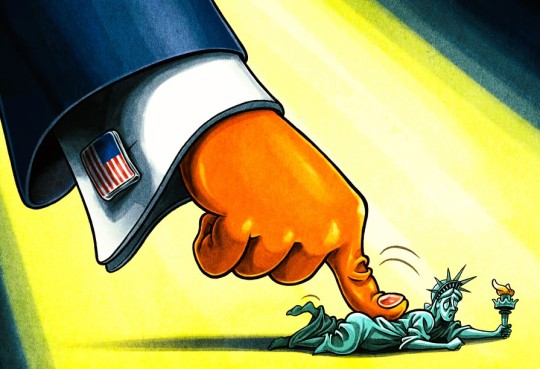I always loved bookstores, coffee shops, music, old movies, foreign languages, travelling, design. Those are the things that I never stopped loving in my life so far. So, I decided to make a blog and put them all together... For me it's magic❗❗✨ All photos belong to their rightful owners. I do not own any of the content I post. Please Note: Blank profiles, Spam or Suspicious Accounts will be BLOCKED AND REPORTED. Copyright © 2014–2025 Just for Books - All rights reserved
Don't wanna be here? Send us removal request.
Text

Are Trump’s tariffs for real or an AI hallucination? I’m afraid the answer is both
Amid claims that a chatbot helped shape the key calculations, the president is now off playing golf. He’ll find the world economy in a bunker
There’s a scene in the very first episode of Yellowstone where the casino-owning Native American chief explains the basic financial logic of all casinos to an uncomfortable politician: “The gamblers’ money is like a river – flowing one way. Our way.” Oh no, hang on, wait … Not all casinos. In fact, it could be that when all is said and done, the historians looking for that one key fact to illustrate the eventual legacy of Donald Trump will not go with his two stunning presidential election wins. Instead, they’ll point out that in the 90s, he literally managed to bankrupt casinos. To repeat: this is a man who somehow contrived to bankrupt multiple casinos. Is he the guy to reshape the entire global economic order of the past century? Let’s find out! Either way, only 45 months of his presidency left to go.
Anyway: tariffs. Rather than using actual tariff data, the United States of America this week appeared to have genuinely used a basic ChatGPT-style model to calculate the tariffs it would immediately impose on friends/foes/arctic wildlife. This was called either “liberation day”, or the “declaration of economic independence” (sadly not abbreviated – yet – to DEI).
It was hosted in the White House Rose Garden by ancient gameshow MC Donald Trump, who was accidentally wearing his indoors makeup outdoors. Like many, I’ve tried to mentally detach from the fact that we live in a time when the US defence secretary has a neck tattoo or whatever, but it makes me feel at least partially alive that the presidential paint job still occasionally retains the power to horrify. Trump leered his way through his tariff presentation while appearing to have been made up by the technique that provided the climax to Joe Wilkinson’s RNLI speech on Last One Laughing (If you saw it, you know). It’s not so much foundation any more as cosmetic bukkake.
Forgive me, back to the economics. We know that Trump has always been obsessed with starkly simple numbers. Network TV ratings. The overall trade balance in goods (not services). And – before this week – the stock market. But now, like Bruno, we don’t talk about the stock market, no no no … Certainly not since it dropped 1,679 points in one day alone (the day after Trump announced the tariffs). Although please enjoy the pure hilarious happenstance of scheduling which meant that that day’s opening bell to signal the start of trading on Wall Street had been rung by the staff of wingnut media outlet Newsmax and Rudy Giuliani. Ding, dong – now just watch those stocks crap the bed. Seriously, Rudy – everything you touch! Then again we do have to remember that it was Trump himself who last year declared that “stock markets are crashing, jobs numbers are terrible, we are heading to World War III and we have two of the most incompetent ‘leaders’ in history. This is not good!!!”
Is he still marking presidencies on the same metrics? Alas, reporters are going to need to shout that inquiry over the fairways, as Trump has now repaired to one of his Floridian golf courses to host the first domestic event of 2025 on the Saudi-owned LIV Golf tour. It’s called class: look it up. And no doubt it’ll be fun discussing falling oil prices with whoever is over from Riyadh for the event.
Trump did offer one last comment on the tariffs before donning his big-boy golf pants. “The operation is over,” he said. “The patient lived, and is healing. The prognosis is that the patient will be far stronger, bigger, better and more resilient than ever before.” A speech I am positive I have heard delivered word-for-word on The Simpsons by ultra-shady physician Dr Nick. Meanwhile, in the back of shot, a Frankenfigure with a fish’s head grafted to a man’s body sits bolt upright, convulses wildly and dies within three foot of the operating table. Listen, you can’t save ‘em all.
Incidentally, Trump is not the only one reaching for medical metaphors. Take the chief economist at UBS Global Wealth Management, who this morning observed mildly: “We often hear that when the US sneezes the global economy catches cold. This is not the US sneezing. This is the US cutting off its own arm. The self-inflicted economic cost naturally weakens the dollar.” Mm. One indication that an economic plan is going badly is that there’s no one responding to the above by going “ooh, but is cutting off your arm even a bad thing?”. Different circumstances, of course, but there was a similar mood in the air in the UK after Liz Truss’s “mini-budget”.
Speaking of Blighty, Keir Starmer seems to have continued his policy of not poking the bear, and indeed to pretend to really enjoy it when the bear pokes you really hard somewhere really painful. According to Trump, Starmer is “very happy” about the 10% tariff kick he just took up the UK’s backside.
Still, perhaps there are already signs of slight directional pivots in the West Wing. Having watched global markets tumble while the White House absolutely insisted that the tariffs were not lazy ChatGPT-assisted gambits to provoke immediate trade negotiations, it wasn’t too long before Trump’s son Eric was venturing on to X with a take. “I wouldn’t want to be the last country that tries to negotiate a trade deal with @realDonaldTrump,” gibbered Trump minor. “The first to negotiate will win – the last will absolutely lose,” he continued. “I have seen this movie my entire life …” Weird, because I don’t remember this particular scene in the aforementioned Trump casino movie – or indeed several epic flops in the franchise.
Yet this was also a week where we were reminded that life is not just about the adult sons with whom we are saddled, but the adult sons we choose. Fire up the elegy muzak, then, for there is sadness in the air. Reports – hotly denied, which means nothing – suggest that Elon Musk will fairly soon be leaving his post at the “department of government efficiency” and returning to the private sector. Yeah, let that sink out. And then try to picture his Doge leaving party. “Sorry boys, tariffs mean we can only afford US beer. And, unfortunately, we eliminated spending on paper cups. On the plus side, the president’s makeup artist is just going to spray Bud Light in the general directions of your mouths, and she has a 30% accurate aim. Open wide, victors!”
All of which would seem to conclude this week’s look at Trump’s river, which a) is a river of effluent and b) only flows one way. Our way. What can I tell you? Buy shares in paddles today.
Daily inspiration. Discover more photos at Just for Books…?
#just for books#Donald Trump#Opinion#US politics#Tariffs#Trump tariffs#Elon Musk#message from the editor
10 notes
·
View notes
Text

Hello Spring🌺 🌼 🌷 🌹 🥀🌻🌺
Daily inspiration. Discover more photos at Just for Books…?
10 notes
·
View notes
Text

As long as there is Chocolate, there will be Happiness 😋 😋 😋
Daily inspiration. Discover more photos at Just for Books…?
6 notes
·
View notes
Text

My Tumblr page is better viewed while naked.
Daily inspiration. Discover more photos at Just for Books…?
6 notes
·
View notes
Text

Do you remember those wonderful Saturday mornings⁉
Daily inspiration. Discover more photos at Just for Books…?
12 notes
·
View notes
Text

Hello Spring🌺 🌼 🌷 🌹 🥀🌻🌺
Daily inspiration. Discover more photos at Just for Books…?
7 notes
·
View notes
Text

Hello Spring🌺 🌼 🌷 🌹 🥀🌻🌺
Daily inspiration. Discover more photos at Just for Books…?
8 notes
·
View notes
Text

«Φανταζόσουν ότι θα έβγαινες στη σύνταξη ως τρομοκράτης;»
Το μυθιστόρημα «Το Σαββατοκύριακο» του Μπέρνχαρντ Σλινκ εξετάζει τις ηθικές και ιδεολογικές συνέπειες της πολιτικής βίας και της τρομοκρατίας, αναδεικνύοντας τις αμφιλεγόμενες αντιπαραθέσεις γύρω από το παρελθόν και το παρόν.
«Άραγε το είχες σκεφτεί ότι μπορεί να πας φυλακή; Το είχες λογαριάσει όπως ο υπάλληλος την απόλυση ή ο γιατρός μια μόλυνση; Επαγγελματικός κίνδυνος; Ή φανταζόσουν ότι θα συνέχιζες για πάντα και θα έβγαινες στη σύνταξη ως τρομοκράτης και θα σε φρόντιζαν στο γηροκομείο οι νεαροί ζηλωτές;» Οι ερωτήσεις πέφτουν σαν το χαλάζι και ο Γιοργκ, μέλος της Φράξιας Κόκκινος Στρατός, με είκοσι χρόνια σκληρής κάθειρξης πίσω του και άρτι ευεργετηθείς με προεδρική χάρη, αρκείται στο να ρίχνει αμήχανες ματιές στους πάλαι ποτέ φίλους του, συνδαιτημόνες του τώρα στο πρώτο ελεύθερο γεύμα του. Κι όσο το σφυροκόπημα συνεχίζεται –«Πώς ήταν ο πρώτος σου φόνος, Γιοργκ; Πού ήσουν όταν τον έκανες; Πήρες απ’ αυτόν κάποιο μάθημα για τη ζωή σου;»– τόσο πιο εύθραυστος και μπερδεμένος εμφανίζεται ο ίδιος…
Ο Γιοργκ δεν είναι άλλος από τον κεντρικό ήρωα του μυθιστορήματος «Το Σαββατοκύριακο» του Μπέρνχαρντ Σλινκ (μτφρ. Αλέξανδρος Κάιμπελ, εκδόσεις Κριτική, 2009). Ο Γερμανός συγγραφέας του «Διαβάζοντας στη Χάνα», πανεπιστημιακός καθηγητής Δημοσίου Δικαίου και Φιλοσοφίας του Δικαίου και δικαστής, επιχειρώντας γι’ άλλη μια φορά να σκαλίσει πληγές της πρόσφατης ιστορίας της πατρίδας του, καταπιάνεται εδώ με το ζήτημα της ένοπλης πάλης που κατέληξε σε τρομοκρατική υστερία, αποφασισμένος να ντύσει τον σχετικό κοινωνικό διάλογο με μυθιστορηματική πλοκή.
Η δράση στο «Σαββατοκύριακο» διαρκεί όσο κι ο τίτλος του βιβλίου και εκτυλίσσεται μέσα σ’ ένα παραδεισένιο, εξοχικό τοπίο, στη φθαρμένη από τον χρόνο έπαυλη όπου έχουν συγκεντρωθεί οι παλιοί φίλοι του πρωταγωνιστή. Η πρωτοβουλία της μάζωξης ανήκει στην αδελφή του Γιοργκ και οι αποδέκτες της πρόσκλησης –συμπαθούντες του αγώνα κάποτε, αν και για διαφορετικούς λόγους ο καθένας– συγκροτούν πια μια ανομοιογενή ομάδα βολεμένων αστών: ένας καταξιωμένος δημοσιογράφος, ένας δικηγόρος, μια μελίρρυτη επίσκοπος, μια δασκάλα που ονειρεύεται να γίνει συγγραφέας, ένας επιχειρηματίας-οδοντεχνικός.
Ανάμεσά τους, εντελώς απροσδόκητα, θα έρθει να προστεθεί κι ένας νεαρός, η ταυτότητα του οποίου θ’ αποκαλυφθεί με καθυστέρηση, ενώ «παρών» δηλώνει κι ένας σύγχρονος αντιεξουσιαστής, ο Μάρκο, που προσκολλάται σαν βδέλλα πάνω στον Γιοργκ για να του αποσπάσει μια δήλωση προς όσους «εξακολουθούν να τον πιστεύουν και να τον περιμένουν», ενώ αντιμάχονται τον παγκοσμιοποιημένο καπιταλισμό.
Άλλοι από τους προσκεκλημένους περιβάλλουν τον Γιοργκ με την αγάπη τους, άλλοι προσπαθούν να ικανοποιήσουν την περιέργειά τους, άλλοι αρπάζουν την ευκαιρία για ένα νοσταλγικό ταξίδι στο παρελθόν. Με εξαίρεση, όμως, τον Μάρκο, όλοι κρατούν τις αποστάσεις τους από τον παλιό τους σύντροφο, καθώς έχουν συμφιλιωθεί με την κοινωνία που ήθελαν στα νιάτα τους να καταστρέψουν κι έχουν αποδεχτεί το αδιέξοδο του φανατισμού και των δολοφονιών. Ο Μπέρνχαρντ Σλινκ μεταμορφώνει με την πένα του τους παραπάνω σ’ ένα ιδιότυπο σώμα ενόρκων και, πατώντας πάνω σε μάλλον σχηματικές δραματουργικές εντάσεις, αναδεικνύει τις ιδεολογικές αντιπαραθέσεις γύρω από το φαινόμενο της βίας – και της επαναστατικής αλλά και της κρατικής. Εκείνο που προτάσσει, όμως, είναι οι αξίες της μετάνοιας, της ατομικής ευθύνης και της συγγνώμης, σαν να λέει ότι δίχως αυτές δεν νοείται καμιά καινούργια αρχή.
Daily inspiration. Discover more photos at Just for Books…?
3 notes
·
View notes
Text

Dear Friday, I'm so glad we are back together 😄 😴 💤
Daily inspiration. Discover more photos at Just for Books…?
4 notes
·
View notes
Text

The Allure of Café Au Lait
Café au lait is the perfect drink to sip on a chilly morning or relaxed afternoon. With its creamy texture and smooth coffee flavors, this classic French beverage evokes feelings of coziness and comfort.
The café au lait combines coffee and heated milk in perfect proportion. The milk helps soften the bitterness of the coffee, while retaining its rich, intoxicating aroma. Each creamy sip delivers notes of dark roasted coffee enveloped in velvety steamed milk.
For many, café au lait is their preferred way to start the day. The ritual of slowly sipping from a comforting bowl or mug helps ease into the morning. The perfect balance of coffee and milk provides a jolt of energy and focus. At the same time, it is soothing and more gentle on the stomach than black coffee alone.
☕ The History and Origins of Café Au Lait
The term “café au lait” comes from French, meaning “coffee with milk”. The drink originated in France in the 17th century. Back then, coffee was an expensive import and considered a luxury beverage of the upper class. By adding heated milk, French people could stretch their precious coffee further.
The traditional way of preparing café au lait is to brew dark roast coffee with a French press. Steamed whole milk is then added to taste. Historically, a bowl was used instead of a mug to accommodate the copious amount of milk added. The café au lait bowl with its milky coffee contents is an iconic part of French cafe culture.
Over time, the drink spread across Europe and then overseas. In New Orleans, café au lait was adopted with enthusiasm and made their own. New Orleans-style café au lait uses chicory in the coffee for its bittersweet flavor. The drink is now a Big Easy breakfast staple, served at famous coffee institutions like Café Du Monde.
☕ Savoring the Café Au Lait Experience
The ritual of preparing and sipping café au lait is an experience unto itself. The aroma of freshly brewed coffee entices the senses. Pouring the steamed milk into the coffee and seeing the fluids merge into creamy swirls is visually satisfying. Some may whisk the drink briefly to incorporate the layers into one luxurious concoction.
Many choose to enjoy their café au lait in a cozy cafe, sipping slowly and savoring the complex flavors. The warmth of the bowl and smooth texture comforts body and soul. For a touch of indulgence, you can add a splash of whipped cream or cinnamon on top.
Preparing café au lait at home can be an equally delightful routine. Curling up on the couch with your steaming bowl is a soothing morning or afternoon treat. The rich yet mellow drink is the perfect accompaniment for reading, chatting with friends, or simply taking life slowly.
Whether enjoyed at home or in a cafe, café au lait is a timeless classic that evokes relaxation, connection, and contentment. Each velvety sip feels like a hug from within. With its iconic French roots and worldly appeal, this coffee-meets-milk beverage is sure to warm hearts for generations to come 😋
Daily inspiration. Discover more photos at Just for Books…?
6 notes
·
View notes
Text

Dear Friday, I’m so glad we are back together. I was thinking of you the whole week.
Daily inspiration. Discover more photos at Just for Books…?
9 notes
·
View notes
Text

I’m crazy about coffee, even crazier without it ☕ ☕ ☕ 😄
Daily inspiration. Discover more photos at Just for Books…?
7 notes
·
View notes
Text

Tiny details and the aesthetics aren’t merely a side note, they’re as important as anything else.
Daily inspiration. Discover more photos at Just for Books…?
2 notes
·
View notes
Text

Good morning❗ 🎶☕🍩
Daily inspiration. Discover more photos at Just for Books…?
14 notes
·
View notes
Text

Genuine beauty is always quite alarming
Daily inspiration. Discover more photos at Just for Books…?
7 notes
·
View notes
Text

Hello Spring🌺 🌼 🌷 🌹 🥀🌻🌺
Daily inspiration. Discover more photos at Just for Books…?
8 notes
·
View notes
Text

As long as there is Chocolate, there will be Happiness 😋😋😋
Daily inspiration. Discover more photos at Just for Books…?
3 notes
·
View notes